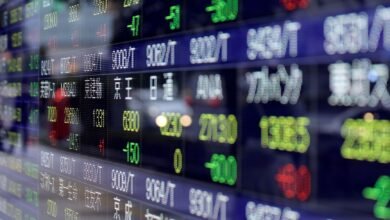Bond Markets on Edge: How Neoliberalism and Soaring Debt Are Shaking Developed Economies

Developed country bond markets are behaving oddly. Government bond prices are falling because holders are leaning towards offloading the debt instruments, and new buyers are more circumspect.
Given that government bonds promise to make payments that are a fixed proportion of the face value of the bond, the yields on these bonds are the inverse of their prices. When prices rise, the yield falls (since the coupon payment isa fixed sum), and vice versa. When yields rise, the government is forced to offer higher rates on the new bonds it sells. Thus, credit is getting more expensive for the government.
According to the “markets”, or their spokespersons, large debt accumulation and “excess” bond issues explain this trend. With the demand for bonds not matching supply, bonds have at different points in time recently traded at values below par. In the financial tsar Jamie Dimon’s view, the US bond market is likely to “crack” because of an unsustainable rise in government debt.
Also Read | Will Trump break world’s faith in US dollar?
These trends are not “normal”. Developed country government bonds in general, and US Treasuries in particular, are considered safe, staid, and steady instruments. They are safe because governments have the right to levy taxes and are therefore seen as capable of mobilising additional revenues to service their financial liabilities. For that and other reasons, governments are unlikely to default on debt service payments. These bonds are also seen as liquid since they can be easily traded or pledged as collateral to access cash when needed. Their prices too are not expected to be volatile.
Given these features of public bonds, it is normal for those who are risk averse to invest in them for safety. Others include them in their portfolio to balance the holdings of riskier assets that offer higher expected returns. That reduces the average risk carried and limits aggregate losses. For such reasons, the demand for government bonds like US Treasuries is seen as elastic: the government can issue them at will to finance expenditures in excess of current revenues.
Why safety is no longer assured
What then explains the uncertainties surrounding public bonds in recent times? To answer that, we need to start with the changed relationship between states and “markets” in the neoliberal era that began in the 1980s. A driving feature of that regime is the accumulation of large volumes of liquidity in the financial system, or capital seeking high returns from financial investments.
A corollary is an increase in demand for financial assets, including bonds, public and private. However, holders of those financial assets are also critical of the fiscal deficits that determine their supply, on the ground that deficit spending by government, financed through bond issues, can trigger inflation. Inflation in the prices of goods and services erodes the real value of financial assets and therefore the real resources it can command. This makes finance capital averse to proactive government spending based on borrowing.
This aversion to deficit spending is problematic because financial investors are also unhappy with taxes above some minimal level as those too eat into profits. So, in the neoliberal “Age of Finance”, governments have kept taxes low and competed to lower tax rates to attract financial investments. They fear that higher-than-neighbour tax rates can lead to the exit of footloose financial investments with adverse growth and balance of payments consequences.
The result is that non-debt receipts of the government in the form of tax revenues that can finance necessary expenditures have been shrinking across the globe, including in the so-called rich nations. With revenues low and deficit spending expected to be reined in, there has been a sharp reduction in spending in the form of curtailed capital and welfare expenditures. Austerity has become the norm.
Despite this, given the quantum of the revenue shortfall, borrowing has been rising. Increased borrowing increases the interest burden on government budgets, which further raises expenditures that are committed and not discretionary. Increased demand for debt from the markets also necessitates offering higher interest rates for the successful completion of bond auctions. That too raises interest payouts and necessitates even larger borrowing.
Expenditure, debt, and the vicious cycle
The effort to stop this vicious circle of debt by reining in expenditures is proving to be increasingly difficult, if not impossible. To start with, there have been shocks stemming from deregulation under neoliberalism, such as the financial implosion of 2008 and the Great Recession that followed, which required spending to moderate their effects and bail out the financial system. There have been health emergencies like the COVID-19 pandemic that necessitated increased spending. Expenditures are also rising because of extreme climate-change-related events like hurricanes, floods, and forest fires.
The result has been larger deficits and further borrowing, often nearing a “Ponzi” situation where debt is incurred today to service past debt. In the US, the bond market has swelled from around $5 trillion in 2008 to close to $30 trillion currently.
This scenario has worsened with an increasing tendency to provide new tax concessions and refuse to end past ones, as in the case of US President Donald Trump’s so-called “One Big Beautiful Budget Bill”. The result has been a potential increase in the deficit, which the government has sought to deny. The Trump administration argues that the recent import tariff hikes will bring in substantial revenues to close the gap. However, markets have not swallowed that reasoning. The result has been periodic declines in bond prices and a rise in yields.
Also Read | Does collapse of key banks in US, Europe portend a return to 2008?
In the UK, the efforts of the government to plug the hole in its finances, by pushing through huge cuts in welfare spending, were in vain because welfare services and benefits have already touched long-time lows. In Europe, the drive to raise defence spending to make up for the loss of strategic US support has made things even more difficult. Welfare cuts are only intensifying, and dissent and violence are on the rise. The message is clear. Neoliberalism, which extracts tax concessions for the rich, generates large, self-reinforcing deficits because the headroom for compensating reductions in welfare expenditures that benefit the majority has more or less shrunk. Capital has only one solution: hit the poor.
But even the system’s authoritarian turn has not helped implement that solution in adequate measure. Meanwhile, cuts in capital spending are leading to a collapse of public infrastructure and setting back already stagnant research and development funding, accelerating a decline in productivity. Neoliberalism is becoming modern-day capitalism’s weapon of self-destruction.
C.P. Chandrasekhar taught for more than three decades at the Centre for Economic Studies and Planning, Jawaharlal Nehru University, New Delhi. He is currently Senior Research Fellow at the Political Economy Research Institute, University of Massachusetts Amherst, US.
Credit: Source link






